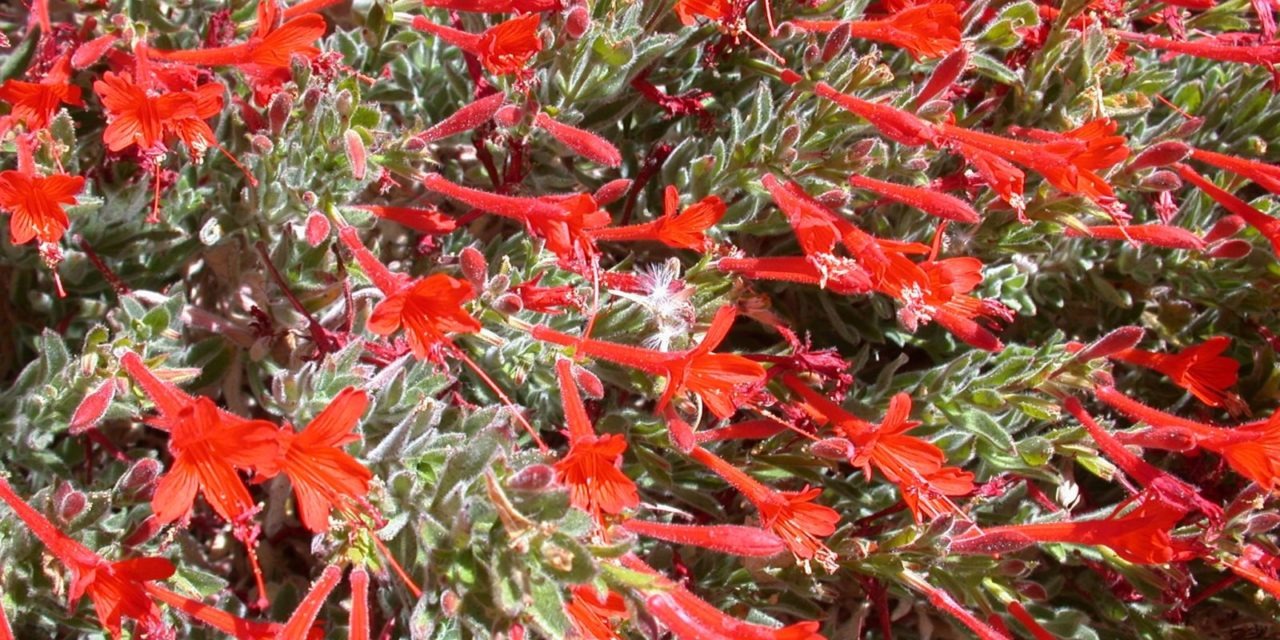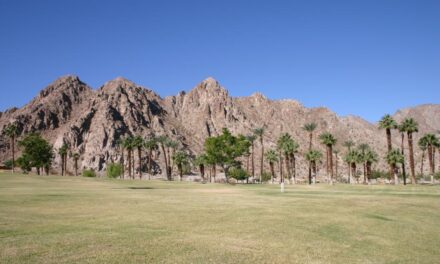A common desert plant along Big Morongo Canyon Trail is mesquite
Day hikers can walk a canyon in the foothills of the Little San Bernardino mountains near Desert Hot Springs.
The 9.8-mile round trip Big Morongo Canyon Trail gains about 1000 feet elevation as it connects the Coachella Valley desert floor to Morongo Valley. Most of the trail sits in the Big Morongo Canyon Preserve.

Canyon Trail head
To reach the trailhead, from Interstate 10 take Calif. Hwy. 62 north. Before entering the foothills, turn right/southeast onto Indian Canyon Road. Watch for a brick structure with a solar panel sticking out of it on the road’s left/north side. Park on the road shoulder and head northeast past the brick structure toward a wash at the base of the foothills.
The trail is sandy, so you’ll need quality hiking boots to traverse it; a walking stick isn’t a bad idea either. In about 0.4 miles, the trail reaches the wash. Follow it into the foothills of the Little San Bernardino Mountains. You’re at the canyon’s bottom.
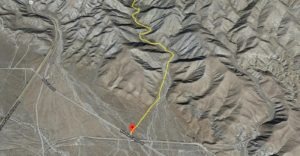
Big Morongo Canyon Trail Plate
The trail heads up the wash of Big Morongo Creek. As it does, the canyon walls narrow, but since you’re gaining elevation, they at times grow shorter.
The Paradise Fire swept through part of the canyon in 2005. More than a decade later, the desert plants – some of which actually depend on fire to spread their seeds – have come back.
Among the canyon’s plants is cat’s claw acacia. A shrub that can grow up to 12 feet tall and 8 feet wide, make sure you don’t brush up against it. Tiny hooked barb thorns grow all along the stems, and when it catches on the skin, the thorn digs deep and leaves a bloody scratch. The shrub ‘s flower blooms in spring, and its nectar is popular with honeybees.
Another interesting plant is coyote brush (aka coyote melon), which bears small gourds. Boasting large leaves and spreading vines, its taproots can spread several feet into the ground. It bears large, bell-shaped flowers. December is a good time to spot the bush’s striped gourd. It’s not edible (though coyotes allegedly enjoy them), but Native Americans used them to make soap and did grind the seed for food.
The California fuchsia also is easy to spot when it’s in bloom, usually during late summer and autumn. Growing up to two feet high, a number of bright pink to red-orange, tubular flowers blossom on each plant.
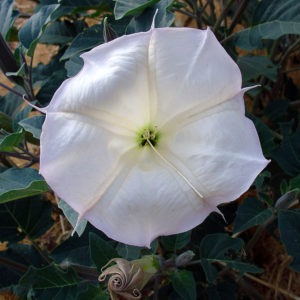
Jimson Weed
Jimson weed is another common plant in the canyon. Growing from a foot to a yard-and-a-half high, its fragrant white flowers bloom from April through October. The flowers usually open in the morning, close during the day’s heat, then reopens at night. The Chumash used the plant in its ceremonies and called it momoy.
Frémont’s cottonwood grows near the trail’s end. Though the riparian tree can reach up to 115 feet high, they’re all fairly young and short here, thanks to the Paradise Fire. Its leaves turn bright yellow – and sometimes orange and red – from October to November, giving a feeling of the Upper Midwest and New England in autumn.
Another common desert plant along the trail is mesquite, which can grow up to 50 feet tall if there’s ample water. Unlike the red shank’s ribbony bark that is easy to peel, the mesquite’s bark is smooth, though when older it grays and the texture appears shredded. Young mesquite branches often are green and photosynthetic. Its leaves fold shut at night.
Streamlets feed Big Morongo Creek, so be careful of not turning off the main route. For the most part, following the right canyon will be easy enough, as the streamlets often are impassable, but one potential mix-up can occur at about 2.65 miles. There the creek splits in a Y. Go right/northeast.
Another potentially confusing split occurs at 3.2 miles. Veer left/west there.
The trail generally is far more lush than the canyon sides. At 4.1 miles, though, the trail becomes particularly verdant. You’re approaching the top of the canyon.
You’re certain to see a variety of birds in this section of the trail.
California scrub jays stretch about 11–12 inches in length. Its blue head, wings and tail with white eyebrows and throat make it stand out against the tawny desert. They eat a variety of foods, from frogs and bird eggs to nuts and berries. Often they store food in hidden caches.
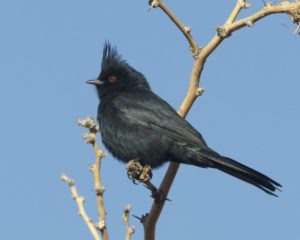
Male Phainopepla
The phainopepla stretches between 6.3–7.9 inches long. The male is glossy black with a visible white patch when it flies; the female is gray. Both genders have a noticeable crest, long tails, and red eyes, though the last is more noticeable in the female. They eat berries, insects and vegetables; it particularly likes desert mistletoe’s fruit.
Extremely small at 4.5 inches in length, the light gray verdin can be spotted thanks to a bright yellow head and reddish-brown shoulder patch. They nest in shrubs and thorny thickets but once paired for breeding will claim a territory as large as 20 acres in size. They typically eat insects, berries and seeds.
At 4.9 miles, the trail reaches the Big Morongo Canyon Preserve, where a plethora of trails run around a small wetlands. This marks a good spot to turn back and retrace your steps to where you parked.
Alternately, you could have someone pick you up at the preserve. This cuts the hike’s distance almost in half. This can be done by taking West Canyon Trail left/northwest. At 5.4 miles, go left/west into the Mesquite Trail then at 5.6 miles, left/northwest into the Marsh Trail, which heads to the main entry and parking lot for a 5.85-mile hike one-way.
Image Sources
- Canyon Trailhead: Rob Bignell
- Jimson Weed: Rob Bignell
- Male Phainopepla: Rob Bignell
- California Fuchsia: Rob Bignell

